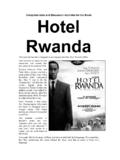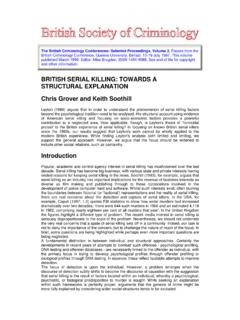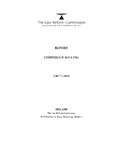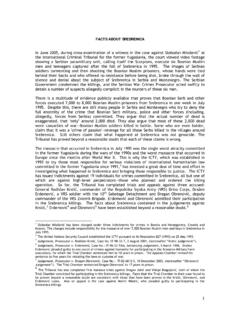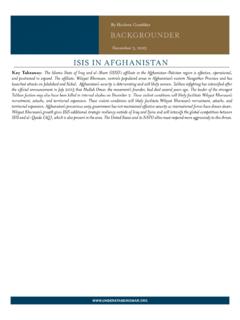Transcription of The Killing Fields - The Curriculum Project
1 Comprehension and Discussion Activities for the Movie The Killing Fields This module has been designed to accompany the film The Killing Fields (1984). The Killing Fields is based on real characters and events that took place in Cambodia under the Khmer Rouge regime during the 1970s. The film follows the story of New York Times journalist Sydney Schanberg and his translator, Cambodian journalist Dith Pran. The module consists of teacher s notes and two handouts that you can copy and give to your students. If you don t have access to a copier, you can write these on the board. You might like to do many of these activities in students first language.
2 It is important that they understand the ideas behind the story, and this is easier in their own language. Teacher s Notes 1. Before You Watch : Useful Vocabulary Here are some useful words and phrases to help students understand the movie: bribe evacuate execute mass grave invade re-education civilian casualties reunited sanitise negotiate Write them on the board, and get students to look them up in their dictionaries. (A mass grave is a place where many people are buried at the same time.) : Background Ask students what they know about Cambodia. Write their ideas on the board. Give copies of the Worksheet: Background Information to your students, or explain this information to them.
3 2. While You Watch : Covering the Story Give copies of Worksheet 2: While You Watch to your students, or write the questions for on the board. Play the film to Answers to Exercise A: 1. journalist 2. translator, Cambodia 3. Vietnam 4. civil war, Khmer Rouge 5. reporting Exercise B: 6, 1, 5, 2, 4, 3 Exercise C: 1. He bribes the army to send them on a boat. 2. Khmer Rouge soldiers. 3. Because they were taking photographs. 4. That the story of the bombings will change so that the American army looks better. Exercise D: 1. T 2. T 3. F 4. F 5. F : Cambodia in Crisis Play the film to If students don t have Worksheet 2, write the exercises on the board before you play the film.
4 Answers to Exercise A: 1. c 2. a 3. a 4. b 5. c Exercise B: 1. The KR have black uniforms and are wearing red scarves. The KR have better weapons. 2. Sydney needs Pran to help report the story. Pran s wife is afraid for him, and wants him to come with the family to safety. Exercise C: 1. tank 2. scared 3. guns, shout 4. executed 5. free, negotiations Teacher s Notes : Leaving Phnom Penh Play the film to If students don t have Worksheet 2, write the exercises on the board before you play the film. Answers to Exercise A: 1. c 2. c 3. d Exercise B: 1. The French Embassy 2. Foreigners with passports 3. An extra English passport 4. A photograph of himself 5. The photograph isn t good enough, so the authorities don t accept the passport 6.
5 He doesn t know if he will survive and see his family again 7. Because he encouraged Pran to stay when his family left : The Killing Fields Play the film to If students don t have Worksheet 2, write the exercises on the board before you play the film. Answers to Exercise A: 3, 6, 2, 5, 1, 4 Exercise B: 1. tomato plants, eating lizards and drinking cow s blood 2. they are executed 3. to encourage people to believe in the Khmer Rouge plan of hard work, agriculture and obedience 4. because he recognises Pran as the man who gave him the Mercedes car decoration back in 1973 : Journalism Award Play the film to If students don t have Worksheet 2, write the exercises on the board before you play the film.
6 Answers to Exercise A: 1. organisations, photograph 2. believe 3. award 4. blames 5. accuses Exercise B: 1. F 2. T 3. T 4. F 5. T : Escape Play the film to the end. If students don t have Worksheet 2, write the exercises on the board before you play the film. Answers to Exercise A: 1. a 2. b 3. d 4. b Exercise B: 4, 1, 3, 7, 5, 2, 6 Exercise C: 1. Phat hears Pran listening to an English language radio programme. 2. Because he tries to stop the Khmer Rouge soldiers Killing each other. 3. In his office in New York. 4. No. When Sydney asks for forgiveness, Pran says There is nothing to forgive. 5. 4 years. The Khmer Rouge take over in 1975, and he reaches the camp in 1979.
7 Teacher s Notes 3. After You Watch : Whose point of view? In The Killing Fields we see the situation from the point of view of two people: Dith Pran and Sydney Schanberg. In groups, students choose another person from the film. Some suggestions are: - Sarun, Pran s driver - Al Rockoff - The young soldier who said Mercedes number one - Ser Meoum, Pran s wife - Phat In groups, students decide what is their point of view. - What were they doing before the Khmer Rouge took over? - How did they feel when the Khmer Rouge took over? - What did they do during the Khmer Rouge time? - What did they do after the Khmer Rouge fell? This information is not part of the film, so students will have to use their imaginations.
8 : Cambodia after the Khmer Rouge The Killing Fields ends in 1979. At the end of the film, we are told that there are still a lot of Cambodian refugees living in camps. This was in 1984. Do the students know what has happened in Cambodia since then? Get students ideas about recent Cambodian history, and write them on the board. Here is a very brief summary of Cambodian history since the Khmer Rouge. You can explain this to your students, or get them to research it themselves and write a short essay or paragraph about it. The Vietnamese invaded Cambodia in 1979, following Khmer Rouge attacks on Vietnamese villages. For ten years Cambodia was ruled by a Vietnamese-backed government, while different groups continued fighting.
9 These groups included the Khmer Rouge, the supporters of the King, and the Vietnamese-backed Cambodian government. In 1991 the United Nations got all sides to agree to a peace plan, disarm, and hold elections. 22,000 UN military and civilian staff went to Cambodia to supervise the elections, and bring the refugees home from the border (between 1979 and 1989 150,000 refugees resettled to the US). The elections were held in 1993. A tribunal (court) has been set up to bring senior Khmer Rouge leaders to trial on genocide charges. Pol Pot, the leader of the Khmer Rouge, died in 1998. Student s Worksheet CambodiaThailand MyanmarLaos VietnamChina Dith Pran and Sydney Schanberg 2008 Worksheet 1: Background Information Cambodia and the Khmer Rouge Cambodia is a country in Southeast Asia, bordered by Vietnam, Laos and Thailand.
10 Cambodia has experienced different kinds of invasions and wars over its long history. From 1863 to 1953, Cambodia was a colony of France. In 1953, Cambodia gained independence. Soon after this, civil war broke out in Vietnam. The North Vietnamese were Communist, supported by China and Russia. South Vietnam, on the other hand, was supported by anti-Communist governments like the United States and France. Cambodia decided to be neutral in this conflict. In 1973 the US military secretly attacked Cambodia because the North Vietnamese military operated from the Vietnam-Cambodia border. The US also bombed suspected Khmer Rouge sites. As a result of these bombings, thousands of Cambodian civilians were killed.
